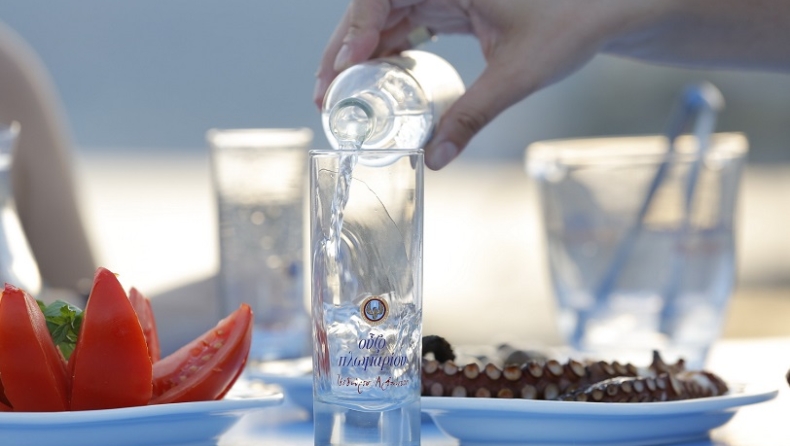
Everything you need to know about ouzo
Learn everything you need to know about ouzo, Greece’s national drink: how it’s drunk, how it’s made, why it turns milky-white when you add water to it and why it tastes of Greek summer!
Imagine yourself sipping a glass of ouzo in the afternoon shade of a Greek island taverna, just as the sun begins to set over the Aegean. Can you pick out the aromas of Greek summer? The taste of friendship, laughter, sunshine… and feel your mind travelling far beyond the city limits of your home?
What is ouzo and what makes it Greek?
Ouzo is the national drink of Greece. And deservedly so. If you’ve never tried it, it’s an aperitif, flavoured with anise or fennel seed, and is exclusively produced in Greece.
While there are other liquorice-scented drinks in the Mediterranean (that also change colour when you add water), ouzo stands out because of its production process. By European law, it is the only one that relates to distilled aniseed and must be produced in a still called an amvyka).
The production process involves the distillation of 96% alcohol by volume spirit, flavoured with a combination of seeds (anise, fennel etc.), spices (cinnamon, clove etc.) and mastiha, according to the recipe of the producer. The specially designed stills are traditionally made of copper and the high quality of the ouzo is ensured by the design and seal of the bottles, which bear all the details of the product and the distiller.

Where does the name ouzo come from?
Ouzo is said to have come from a story involving an Italian (or Ionian Island) trading company, which packaged a batch of exceptional quality tsipouro that was heavily scented with anise. The boxes were marked ‘uso Massalia’ (for use in Marseille, the destination), which became a ‘slogan’ for high-quality tsipouro flavoured with anise and was soon abbreviated. In time, ouzo was standardised as another, distinct drink.
Other, less probable, versions are that it comes from a corruption of the ancient Greek verb ozo (I smell) or – even more extreme – from ‘ou zo’ (I do not live – in other words, I can’t live without ouzo!).
How do Greeks drink ouzo?
Most Greeks drink ouzo with ice cubes. But experts claim that ice (unless it’s from distilled water and so crystal-clear) alters the composition of ouzo and so recommend using cold water instead. Either way, first bring the glass of ouzo to your nose and then taste it neat to fully appreciate the aromatic complexity. Then go ahead and add an ice cube or cold water.
One detail that’s good to know if you’re adding both ice and water: To avoid crystals forming, add water first and then ice. And take your time to watch the transparent liquid turning cloudy. Ouzo is meant to be drunk slowly.

Why does ouzo turn cloudy?
The essential oils of anise and fennel seed that create the classic liquorice aroma and taste are soluble in high-grade, neat ouzo. But when water or ice are added, the alcohol content drops and the essential oils come out of solution, reappearing as a white precipitate. As well as the colour change, the level of the aromas released increases, flooding the senses.
Do you always drink ouzo with food?
You’ll often see ouzo being accompanied by a classic Greek meze appetiser, but there are also occasions when you can drink it without food. The decision might well have to do with where in Greece the ouzo comes from. If it’s from Macedonia, it won’t contain sugar and so will be drier than ouzos from elsewhere, making the accompaniment of an appetiser more important. The ouzos of southern Greece, on the other hand, contain sugar, meaning they can easily be drunk without an appetiser.
When choosing what to eat with your ouzo, you could say the flavours of the meze need to be conflicting – aggressive even: sour with salty, sweet with bitter, with ouzo always prevailing between them.
Try it with all kinds of seafood and you’ll understand: Clams, mussels and scallops, sardines that are salted or grilled on the coals, marinated or dry-fried anchovies, or succulent char-grilled octopus. And not just seafood: Freshly fried aubergines or courgettes (dipped in tzatziki), taramosalata, pickles and capers are all favourite ouzo accompaniments. As are kopanisti and tyrokafteri (peppery cheeses) and avgotaraho (preserved cod roe from Messolongi, in Western Greece). But the best meze could be the simple, delicious taste of a tomato and cucumber – chopped, salted, drizzled with olive oil and served with plenty of crushed olives.
At the same time, if you want, you can also enjoy ouzo as an aperitif before meals (with ice or neat), and there are cocktails made with ouzo, giving a unique flavour.
